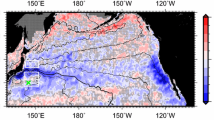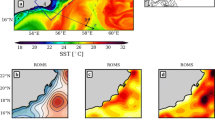Abstract
Effects of mesoscale eddies on the marine ecosystem in the Kuroshio Extension (KE) region are investigated using an eddy-resolving coupled physical-biological model. The model captures the seasonal and intra-seasonal variability of chlorophyll distribution associated with the mesoscale eddies, front variability, Kuroshio meanders, and upwelling. The model also reproduces the observed interannual variability of sea surface height anomaly (SSHA) in the KE region along a zonal band of 32–34°N from 2002 to 2006. The distribution of high surface chlorophyll corresponds to low SSHA. Cyclonic eddies are found to detach from the KE jet near 150°E and 158°E and propagate westward. The westward propagating cyclonic eddies lift the nutrient-rich thermocline into the euphotic zone and maintain high levels of chlorophyll in summer. In the subsurface layer, the pattern in chlorophyll is influenced by both lateral and vertical advection. In winter, convection inside the eddy entrains high levels of nutrients into the mixed layer, increasing production, and resulting in high chlorophyll concentration throughout the surface mixed layer. There is significant interannual variability in both the cyclonic eddy activity and the surface phytoplankton bloom south of the KE jet, although whether or not there is a causal link is unclear.








Similar content being viewed by others
References
Banse K, English DC (1999) Comparing phytoplankton seasonality in the eastern and western subarctic Pacific and the western Bering Sea. Prog Oceanogr 43:235–288
Ebuchi N, Hanawa K (2001) Trajectory of mesoscale eddies in the Kuroshio recirculation region. J Oceanogr 57:471–480
Evans GT, Parslow JS (1985) A model of annual plankton cycles. Biol Oceanogr 3:328–347
Falkowski P, Zieman D, Kolber Z, Bienfang P (1991) Role of eddy-pumping in enhancing primary production in the ocean. Nature 353:55–58
Fasham MJR (1995) Variations in the seasonal cycle of biological production in subarctic oceans: a model sensitivity analysis. Deep-Sea Res 42:1111–1149
Goes JI, Sasaoka K, Gomes HR, Saitoh S, Saino T (2004) A comparison of the seasonality and interannual variability of phytoplankton biomass and production in the western and eastern gyres of subarctic Pacific using multi-sensor satellite data. J Oceanogr 60:75–91
Gruber N, Frenzel H, Doney SC, Marchesiello P, McWilliams JC, Moisan JR, Oram JJ, Plattner G-H, Stolzenbach KD (2006) Eddy-resolving simulation of plankton ecosystem dynamics in the California Current System. Deep-Sea Res 53:1483–1516
Hurlburt HE, Wallcraft AJ, Schmitz WJ, Hogan PJ, Metzger EJ (1996) Dynamics of the Kuroshio/Oyashio current system using eddy-resolving models of the North Pacific Ocean. J Geophys Res 101:941–976
Hurtt GC, Armstrong RA (1996) A pelagic ecosystem model calibrated with BATS data. Deep-Sea Res II 43:653–683
Kalnay E, Kanamitsu M, Kistler R et al (1996) The NCEP/NCAR 40-year reanalysis project. Bull Am Meteorol Soc 77:437–471
Kimura S, Kasai A, Nakata H, Sugimoto T, Shimpson JH, Cheok JVS (1997) Biological productivity of meso-scale eddies caused by frontal distributions in the Kuroshio. ICES J Mar Sci 54:179–192
Kimura S, Nakata H, Okazaki Y (2000) Biological production in meso-scale eddies caused by frontal distributions of Kuroshio Extension. ICES J Mar Sci 57:133–142
Kubota M, Iwasaka N, Kizu S et al (2002) Japanese ocean flux data sets with use of remote sensing observations (J-OFURO). J Oceanogr 58:213–225
Kutsuwada K (1998) Impact of wind/wind-stress field in the North Pacific constructed by ADEOS/NSCAT data. J Oceanogr 54:443–456
Martin AP, Pondaven P (2003) On estimates for the vertical nitrate flux due to eddy-pumping. J Geophys Res 108:3359. doi:10.1029/2003JC001841
Masumoto Y, Sasaki H, Kagimoto T, Komori N, Ishida A, Sasai Y, Miyama T, Motoi T, Mitsudera H, Takahashi K, Sakuma H (2004) A fifty-year-eddy-resolving simulation of the world ocean: preliminary outcomes of OFES (OGCM for the Earth Simulator). J Earth Simul 1:35–56
McGillicuddy DJ, Robinson AR (1997) Eddy-induced nutrient supply and new production in the Sargasso Sea. Deep-Sea Res 44:1427–1450
McGillicuddy DJ, Johnson R, Siegel DA, Michales AF, Bates NR, Knap AH (1999) Mesoscale variations of biological properties in the Sargasso Sea. J Geophys Res 104:13381–13394
McGillicuddy DJ, Anderson LA, Bates NR, Bibby T, Buesseler KD, Carlson CA, Davis CS, Ewart C, Falkowski PG, Goldthwait SA, Hansell DA, Jenkins WJ, Johnson R, Kosnyrev VK, Ledwell JR, Li QP, Siegel DA, Steinberg DK (2007) Eddy/wind interactions simulate extraordinary mid-ocean plankton blooms. Science 316:1021–1026
Mizuno K, White WB (1983) Annual and interannual variability in the Kuroshio Current system. J Phys Oceanogr 13:1847–1867
Oschlies A (2001) Model-derived estimates of new production: new results point towards lower values. Deep-Sea Res II 48:2173–2197
Oschlies A (2002) Can eddies make ocean deserts bloom? Global Biogeochem Cycles 16:1106. doi:10.1029/2001GB001830
Oschlies A, Garçon V (1999) An eddy-permitting coupled physical-biological model of the North Atlantic 1. Sensitivity to advection numerics and mixed layer physics. Glob Biogeochem Cycles 13:135–160
Oschlies A, Koeve W, Garçon V (2000) An eddy-permitting coupled physical-biological model of the North Atlantic: 2. Ecosystem dynamics and comparison with satellite and JGOFS local station data. Global Biogeochem Cycles 14:499–523
Pacanowski RC, SM Griffies (2000) MOM 3.0 Manual. Geophysical Fluid Dynamics Laboratory/National Oceanic and Atmospheric Administration, p 680
Qiu B, Chen S (2005) Variability of the Kuroshio Extension jet, recirculation gyre and mesoscale eddies on decadal timescales. J Phys Oceanogr 35:2090–2103
Sarmiento JL, Slater RD, Fasham MJR, Ducklow HW, Toggweiler JR, Evans GT (1993) A seasonal three-dimensional ecosystem model of nitrogen cycling in the North Atlantic euphotic zone. Global Biogeochem Cycles 7:417–450
Sasai Y, Ishida A, Sasaki H, Kawahara S, Uehara H, Yamanaka Y (2006) A global eddy-resolving coupled physical and biological model: physical influences on a marine ecosystem in the North Pacific. Simulation 82:467–474
Sasai Y, Sasaoka K, Sasaki H, Ishida A (2007a) Seasonal and intra-seasonal variability of chlorophyll-a in the North Pacific: model and satellite data. J Earth Simul 8:3–11
Sasai Y, Sasaki H, Sasaoka K, Ishida A, Yamanaka Y (2007b) Marine ecosystem simulation in the eastern tropical Pacific with a global eddy resolving coupled physical-biological model. Geophys Res Lett 34:L23601. doi:10.1029/2007GL031507
Sasaoka K, Saitoh S, Asanuma I, Imai K, Honda M, Nojiri Y, Saino T (2002) Temporal and spatial variability of chlorophyll-a in the western subarctic Pacific determined from satellite and ship observations from 1997 to 1999. Deep-Sea Res II 49:5557–5576
Siegel DA, McGillicuddy DJ, Fields EA (1999) Mesoscale eddies, satellite altimetry, and new production in the Sargasso Sea. J Geophys Res 104:13359–13379
Taguchi B, Xie S-P, Schneider N, Nonaka M, Sasaki H, Sasai Y (2007) Decadal variability of the Kuroshio Extension: observation and an eddy-resolving model hindcast. J Climate 20:2357–2377
Williams RG, Follows MJ (2003) Physical transport of nutrients and the maintenance of biological production. In: Fasham MJR (ed) Ocean biogeochemistry: the role of the ocean carbon cycle in global change. Springer, New York, pp 19–51
Acknowledgments
We thank Drs. Yukio Masumoto, Takashi Kagimoto, and Shintaro Kawahara for their collaborations in extending the OFES model for biological research. The QSCAT product of J-OFURO was obtained from Prof. Kunio Kutuwada. Sea surface height and ocean color satellite data were obtained from Prof. Bo Qiu and Dr. Kosei Sasaoka. OFES simulations were conducted on the Earth Simulator under support of JAMSTEC. This work was partly supports by CREST, JST. We would like to thank the anonymous reviewers for their valuable comments and suggestions.
Author information
Authors and Affiliations
Corresponding author
Additional information
Responsible Editor: Jin-Song von Storch
Appendix
Appendix
1.1 Ecosystem model
The marine ecosystem model is a simple nitrogen-based Nitrate, Phytoplankton, Zooplankton, and Detritus (NPZD) pelagic model (Oschlies 2001). The evolution of any biological tracer concentration C i in the OFES is governed by an advective-diffusive-reaction equation
where the first and second terms on the right-hand side represent advection and diffusion, respectively. The velocity vector, u, is given by OFES, and the lateral and vertical diffusion coefficients, Ah and Az, are the same as used for tracer fields in OFES. The last term is the source-minus-sink term due to biological activity. For the individual biological tracers (Phytoplankton, P; Zooplankton, Z; Detritus, D; and Nitrate, N), the source-minus-sink terms are given by
where \( \overline J \) is the daily averaged phytoplankton growth rate as a function of depth z, time t, and nitrate concentration, N. G is the grazing function. Following Hurtt and Armstrong (1996), the phytoplankton growth rate is taken to be the minimum of light- and nutrient-limited growth,
where \( \overline J \left( {z,t} \right) \) denotes the purely light-limited growth rate averaged over 24 h, and J max is the light-saturated growth. \( \overline J \left( {z,t} \right) \) is computed using the analytical method of Evans and Parslow (1985).
where
Following Fasham (1995), the grazing of phytoplankton by zooplankton is given by
The individual biological parameters are listed in Table 1.
Rights and permissions
About this article
Cite this article
Sasai, Y., Richards, K.J., Ishida, A. et al. Effects of cyclonic mesoscale eddies on the marine ecosystem in the Kuroshio Extension region using an eddy-resolving coupled physical-biological model. Ocean Dynamics 60, 693–704 (2010). https://doi.org/10.1007/s10236-010-0264-8
Received:
Accepted:
Published:
Issue Date:
DOI: https://doi.org/10.1007/s10236-010-0264-8




